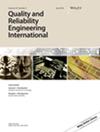基于粒子群算法的共因失效混合冲击模型参数求解研究与验证
IF 2.8
3区 工程技术
Q3 ENGINEERING, INDUSTRIAL
引用次数: 0
摘要
混合冲击模型是一种基于组件独立失效、系统非致命冲击和致命冲击失效的失效概率模型的显式构建方法,它考虑了冗余系统中的共因失效(CCF)。针对航空航天系统,提出了一种改进的混合冲击模型,该模型考虑了多个组件在运行中可能同时独立失效的情况。为了解决混合冲击模型参数无法直接根据故障概率数据求解的问题,提出了一种基于粒子群优化(PSO)算法的参数求解方法。此外,还推导了故障概率与参数变化梯度之间的关系,并提出了基于参数变化梯度的降阶(RO)解法,以提高求解效率。提出了基于求解概率与真实概率相对误差的拟合函数构造方法,以提高多组件失效概率求解精度。研究了结合拟合度变化的非线性惯性因子优化方法,以改进粒子群动力学。比较了不同参数求解序列和不同 PSO 方法的结果精度,验证了 RO 解的有效性。将混合冲击模型修改前后的结果与不同的 CCF 数据进行比较,验证了修改后的混合冲击模型的有效性和广泛适用性。结果表明,修正后的 CCF 混合冲击模型及其参数求解方法能显著提高所有组件失效概率求解精度,也为多冗余系统失效定量分析提供了新的理论依据和求解方法。本文章由计算机程序翻译,如有差异,请以英文原文为准。
Research and verification on parameter solution of mixed shock model for common cause failure based on particle swarm algorithm
Mixed shock model is an explicit construction method of failure probability model based on component independent failure, system nonfatal shock, and fatal shock failure, which considers common cause failure (CCF) in redundant system. For aerospace systems, a modified mixed shock model is proposed, which considers several components may fail independently and simultaneously in operation. In order to solve the issue that the parameters of the mixed shock model cannot be solved directly based on the failure probability data, a parameter solving method based on particle swarm optimization (PSO) algorithm is proposed. Additionally, the relationship between the failure probability and the gradient of the parameter change is deduced, and the reduced‐order (RO) solution based on the gradient of the parameter change is proposed to improve the efficiency of the solution. A fitness function construction method based on the relative error of the solution probability and the true probability is proposed to improve the probability solution accuracy of multicomponent failure. The nonlinear inertia factor optimization method combined with fitness change is studied to improve the particle swarm dynamics. The accuracy of the results of different parameters solving sequence and different PSO methods are compared, and the effectiveness of the RO solution is verified. The results of the mixed shock model before and after modification are compared with the different CCF data, which verifies the effectiveness and wide applicability of the modified mixed shock model. The results show that the modified mixed shock model for CCF and its parameter solution method can significantly improve the probability solution accuracy of all components failure, and also provide a new theoretical basis and solution method for the quantitative analysis of multiredundant system failure.
求助全文
通过发布文献求助,成功后即可免费获取论文全文。
去求助
来源期刊
CiteScore
4.90
自引率
21.70%
发文量
181
审稿时长
6 months
期刊介绍:
Quality and Reliability Engineering International is a journal devoted to practical engineering aspects of quality and reliability. A refereed technical journal published eight times per year, it covers the development and practical application of existing theoretical methods, research and industrial practices. Articles in the journal will be concerned with case studies, tutorial-type reviews and also with applications of new or well-known theory to the solution of actual quality and reliability problems in engineering.
Papers describing the use of mathematical and statistical tools to solve real life industrial problems are encouraged, provided that the emphasis is placed on practical applications and demonstrated case studies.
The scope of the journal is intended to include components, physics of failure, equipment and systems from the fields of electronic, electrical, mechanical and systems engineering. The areas of communications, aerospace, automotive, railways, shipboard equipment, control engineering and consumer products are all covered by the journal.
Quality and reliability of hardware as well as software are covered. Papers on software engineering and its impact on product quality and reliability are encouraged. The journal will also cover the management of quality and reliability in the engineering industry.
Special issues on a variety of key topics are published every year and contribute to the enhancement of Quality and Reliability Engineering International as a major reference in its field.

 求助内容:
求助内容: 应助结果提醒方式:
应助结果提醒方式:


